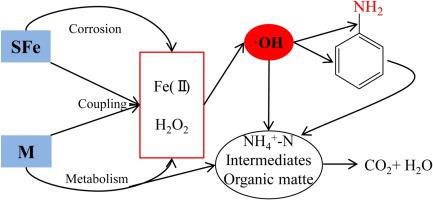当前位置:
X-MOL 学术
›
Process Biochem.
›
论文详情
Our official English website, www.x-mol.net, welcomes your feedback! (Note: you will need to create a separate account there.)
Influencing factors for the Fenton-like of biological sponge iron system and its degradation mechanism of aniline
Process Biochemistry ( IF 4.4 ) Pub Date : 2021-02-01 , DOI: 10.1016/j.procbio.2020.11.012 Hui-na Xie , Jie Li , Ya-e Wang , Wei Zhao , Li-hong Zhang , Jing Li
Process Biochemistry ( IF 4.4 ) Pub Date : 2021-02-01 , DOI: 10.1016/j.procbio.2020.11.012 Hui-na Xie , Jie Li , Ya-e Wang , Wei Zhao , Li-hong Zhang , Jing Li

|
Abstract The application of zero-valent iron (ZVI) coupled with microorganisms, has gained considerable attention in recent years for eliminating recalcitrant organic matters from wastewater. Nevertheless, there are no general conclusions regarding the degradation mechanism and the operating variables. In this paper, sponge iron (SFe, a kind of ZVI) has been submerged to the activated sludge process to develop a biological sponge iron system (SFe-M). The treatment impact of SFe-M system on aniline (AN) wastewater under the optimal conditions was significantly better than that of the general activated sludge system. In the SFe-M system, the variation trends of hydroxyl radicals (•OH) production were consistent with those of Fe(II), and the hydrogen peroxide concentration was approximately twice as high as the sum of activated sludge system and the SFe system. Both SFe and microorganisms could induce Fenton-like reactions directly or indirectly. This contributed to the production of •OH that constantly attacked the benzene ring and the amino group. It resulted in some nitrogen in AN released in the form of ammonia ions. Moreover, microorganisms could also use the mass and electrons during the AN conversion process. The AN was eventually oxidized to carbon dioxide.
中文翻译:

生物海绵铁类芬顿体系的影响因素及苯胺降解机理
摘要 近年来,零价铁(ZVI)与微生物联合应用在去除废水中的顽固有机物方面得到了广泛的关注。然而,没有关于退化机制和操作变量的一般结论。本文将海绵铁(SFe,ZVI的一种)浸入活性污泥法中,开发了一种生物海绵铁系统(SFe-M)。SFe-M系统在最佳条件下对苯胺(AN)废水的处理效果明显优于一般活性污泥系统。在SFe-M体系中,羟基自由基(•OH)产生的变化趋势与Fe(II)一致,过氧化氢浓度约为活性污泥系统和SFe系统总和的两倍。SFe 和微生物均可直接或间接诱发类芬顿反应。这有助于产生不断攻击苯环和氨基的 •OH。这导致 AN 中的一些氮以氨离子的形式释放。此外,微生物还可以在 AN 转换过程中使用质量和电子。AN最终被氧化成二氧化碳。微生物还可以在 AN 转换过程中使用质量和电子。AN最终被氧化成二氧化碳。微生物还可以在 AN 转换过程中使用质量和电子。AN最终被氧化成二氧化碳。
更新日期:2021-02-01
中文翻译:

生物海绵铁类芬顿体系的影响因素及苯胺降解机理
摘要 近年来,零价铁(ZVI)与微生物联合应用在去除废水中的顽固有机物方面得到了广泛的关注。然而,没有关于退化机制和操作变量的一般结论。本文将海绵铁(SFe,ZVI的一种)浸入活性污泥法中,开发了一种生物海绵铁系统(SFe-M)。SFe-M系统在最佳条件下对苯胺(AN)废水的处理效果明显优于一般活性污泥系统。在SFe-M体系中,羟基自由基(•OH)产生的变化趋势与Fe(II)一致,过氧化氢浓度约为活性污泥系统和SFe系统总和的两倍。SFe 和微生物均可直接或间接诱发类芬顿反应。这有助于产生不断攻击苯环和氨基的 •OH。这导致 AN 中的一些氮以氨离子的形式释放。此外,微生物还可以在 AN 转换过程中使用质量和电子。AN最终被氧化成二氧化碳。微生物还可以在 AN 转换过程中使用质量和电子。AN最终被氧化成二氧化碳。微生物还可以在 AN 转换过程中使用质量和电子。AN最终被氧化成二氧化碳。



























 京公网安备 11010802027423号
京公网安备 11010802027423号